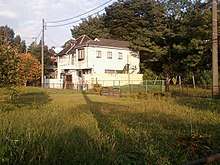Setagaya family murder
| Setagaya family murder | |
|---|---|
 The home where the murders took place, as it appeared in 2010. Houses neighboring the home at the time of the murders have since been demolished. | |
| Location | Setagaya, Tokyo, Japan |
| Date | December 30, 2000 |
| Target | Miyazawa family |
Attack type | Mass murder, home invasion |
| Weapons | Knife |
| Deaths | 4 |
| Victims |
|
| Perpetrator | Unknown |
The Setagaya family murder (世田谷一家殺害事件 Setagayaikkasatsugaijiken) refers to the unsolved murders of the Miyazawa family in Setagaya, Japan on December 30, 2000. Despite a massive investigation that uncovered many specific clues about the killer's identity, the perpetrator was never caught.
Every year, the Tokyo Metropolitan Police Department makes an annual pilgrimage to the house for memorial ceremonies.[1][2] The Seijo Police Station is designated to investigate the case.[3]
Murders
44-year-old Mikio Miyazawa, his 41-year-old wife Yasuko, and their children, 8-year-old Niina and 6-year-old Rei, were discovered murdered in their house on December 31, 2000, by Yasuko's mother Asahi Geino.[4] Rei had been strangled while the rest of the family had been stabbed.[5]
Analysis of the crime scene concluded that the family had been murdered on December 30, after which the killer stayed in the house for several hours. The killer used the family computer and ate ice cream before leaving. The killer also left numerous articles of his clothing at the scene, as well as the two knives which were used in the killings.[5][6]
A taxi driver in the area reported picking up three middle-aged men around the time of the murder. The men left behind blood marks on the back seat after leaving.[6]
Investigation
The investigation into the murders is among the largest in Japanese history, involving over 246,044 investigators who have collected over 12,545 pieces of evidence.[7] As of 2015, forty officers were still assigned to the case full-time.[5] Police have been able to deduce several very specific clues to the perpetrator's identity, but to no avail.
Police determined that the killer had eaten string beans and sesame seeds the previous day after analyzing feces from the killer in the Miyazawa's bathroom.[4] They determined that the clothes and knife left behind by the killer had been purchased in the Kanagawa Prefecture. Police also learned that only 130 units of the sweater were made and sold, but they have only been able to track down twelve of the people who bought the sweaters.[5]
Suspect
A December 30, 2017, DNA analysis has revealed that traces of blood (type A) found at the scene not belonging to the family suggests that the killer has a mother of European descent, possibly from a country near the Mediterranean or Adriatic Sea. Analysis of the Y-chromosome has revealed that the killer's father is of Asian descent, with the DNA appearing in 1 in 4 or 5 Koreans, 1 in 10 Chinese, and 1 in 13 Japanese. He is believed to be about 170 cm tall and of thin build.[8].
References
- ↑ https://japantoday.com/category/crime/setagaya-family-murders-remain-unsolved-17-years-later
- ↑ https://mainichi.jp/english/articles/20171231/p2a/00m/0na/013000c
- ↑ http://www.keishicho.metro.tokyo.jp/multilingual/english/safe_society/wanted/cash_reward.html
- 1 2 "New book claims to shed light on Setagaya family murders in 2000". Japan Today. December 13, 2015. Retrieved June 19, 2016.
- 1 2 3 4 "Setagaya family murders remain unsolved 15 years later". Japan Today. December 31, 2015. Archived from the original on July 26, 2016. Retrieved June 19, 2016.
- 1 2 Watts, Jonathan (January 7, 2001). "Brutal murder of family heightens Japanese fears". The Guardian. Retrieved February 11, 2018.
- ↑ "Police vow to solve 2000 murder of Tokyo family". The Mainichi. December 31, 2015. Retrieved June 19, 2016.
- ↑ Setagaya family murders remain unsolved 17 years later - Japan today (12/30/2017)
External links
| Wikimedia Commons has media related to Setagaya family murder case. |
- Tokyo Metropolitan Police Department investigation website, including pictures of the suspect's clothing (in Japanese)
- Pictures of the victims' home and surrounding area (in Japanese)
- New Information about the suspect(in Japanese)